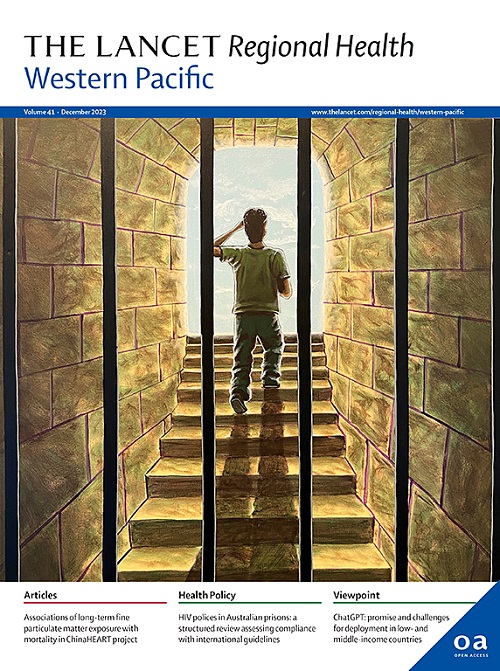IF 7.6
1区 医学
Q1 HEALTH CARE SCIENCES & SERVICES
引用次数: 0
摘要
背景中国肺癌患者在病程中会出现各种癌症相关症状,这些症状通常以症状群的形式出现,导致患者症状负担沉重、生活质量低下。识别症状群和核心症状有利于制定症状管理干预措施,从而改善肺癌患者的健康相关预后。方法经伦理委员会批准,在中国西南地区最具影响力的综合医院之一进行了一项横断面研究。采用 MD 安德森症状量表和修订后的肺癌专用模块收集肺癌患者的症状体验。研究结果共招募了 219 名肺癌患者。确定了四个症状集群,分别是精神神经症状集群、呼吸系统症状集群、胃肠道症状集群和疲劳相关症状集群,这四个症状集群可解释总方差的 59%。症状严重性网络分析结果显示,气短(rc= 1.35)是所有症状中密切度得分最高的症状。在症状群网络中,气短(rc= 1.35)、食欲不振(rc= 1.27)、疲劳(rc= 1.04)和嗜睡(rc= 0.82)分别是四个症状群中接近度得分最高的症状。核心症状的识别为医护人员提供了潜在的干预目标,有助于今后临床实践中对肺癌患者进行症状管理。需要根据症状群采取有针对性的干预措施,以协同减轻症状负担,从而改善患者的预后。本文章由计算机程序翻译,如有差异,请以英文原文为准。
Symptom clusters and core symptoms of Chinese patients with lung cancer: a cross-sectional study
Background
Chinese lung cancer patients experience various cancer-related symptoms during the course of disease, which usually occur as symptom clusters, leading to heavy symptom burden and low quality of life. Identifying symptom cluster and core symptom is conducive to developing symptom management interventions so as to improve health-related outcomes of patients with lung cancer. To investigate the symptom clusters and core symptom of Chinese patients with lung cancer.
Methods
Approved by the ethics committee, a cross-sectional study was conducted at one of the most influential general hospitals in Southwest China. The MD Anderson Symptom Inventory and the revised lung cancer-specific module were utilized to collect symptom experience of patients with lung cancer. R within the RStudio platform was used to conduct descriptive statistics, exploratory factor analysis and network analysis.
Findings
A total of 219 lung cancer patients were recruited. Four symptom clusters were identified as psychoneurological, respiratory, gastrointestinal and fatigue-related symptom clusters, which could explain 59% of the total variance. The results of the symptom severity network analysis revealed that short of breath (rc= 1.35) was the symptom with the highest closeness score among all symptoms. In the symptom clusters network, short of breath (rc= 1.35), lack of appetite (rc= 1.27), fatigue (rc= 1.04) and feeling drowsy (rc= 0.82) were the symptoms with the closeness score in the four symptom clusters, respectively.
Interpretation
Chinese lung cancer patients experienced four symptom clusters among lung cancer patients, which highlighted the significance of addressing general symptoms and cancer-specific symptoms in cancer symptom cluster management. The identification of core symptoms offered health care professionals potential interventional targets in future clinical practice in symptom management among patients with lung cancer. Tailored interventions based on symptom clusters are needed to synergistically reduce the symptom burden, thereby improving patients’ outcomes.
求助全文
通过发布文献求助,成功后即可免费获取论文全文。
去求助
来源期刊

The Lancet Regional Health: Western Pacific
Medicine-Pediatrics, Perinatology and Child Health
CiteScore
8.80
自引率
2.80%
发文量
305
审稿时长
11 weeks
期刊介绍:
The Lancet Regional Health – Western Pacific, a gold open access journal, is an integral part of The Lancet's global initiative advocating for healthcare quality and access worldwide. It aims to advance clinical practice and health policy in the Western Pacific region, contributing to enhanced health outcomes. The journal publishes high-quality original research shedding light on clinical practice and health policy in the region. It also includes reviews, commentaries, and opinion pieces covering diverse regional health topics, such as infectious diseases, non-communicable diseases, child and adolescent health, maternal and reproductive health, aging health, mental health, the health workforce and systems, and health policy.
 求助内容:
求助内容: 应助结果提醒方式:
应助结果提醒方式:


